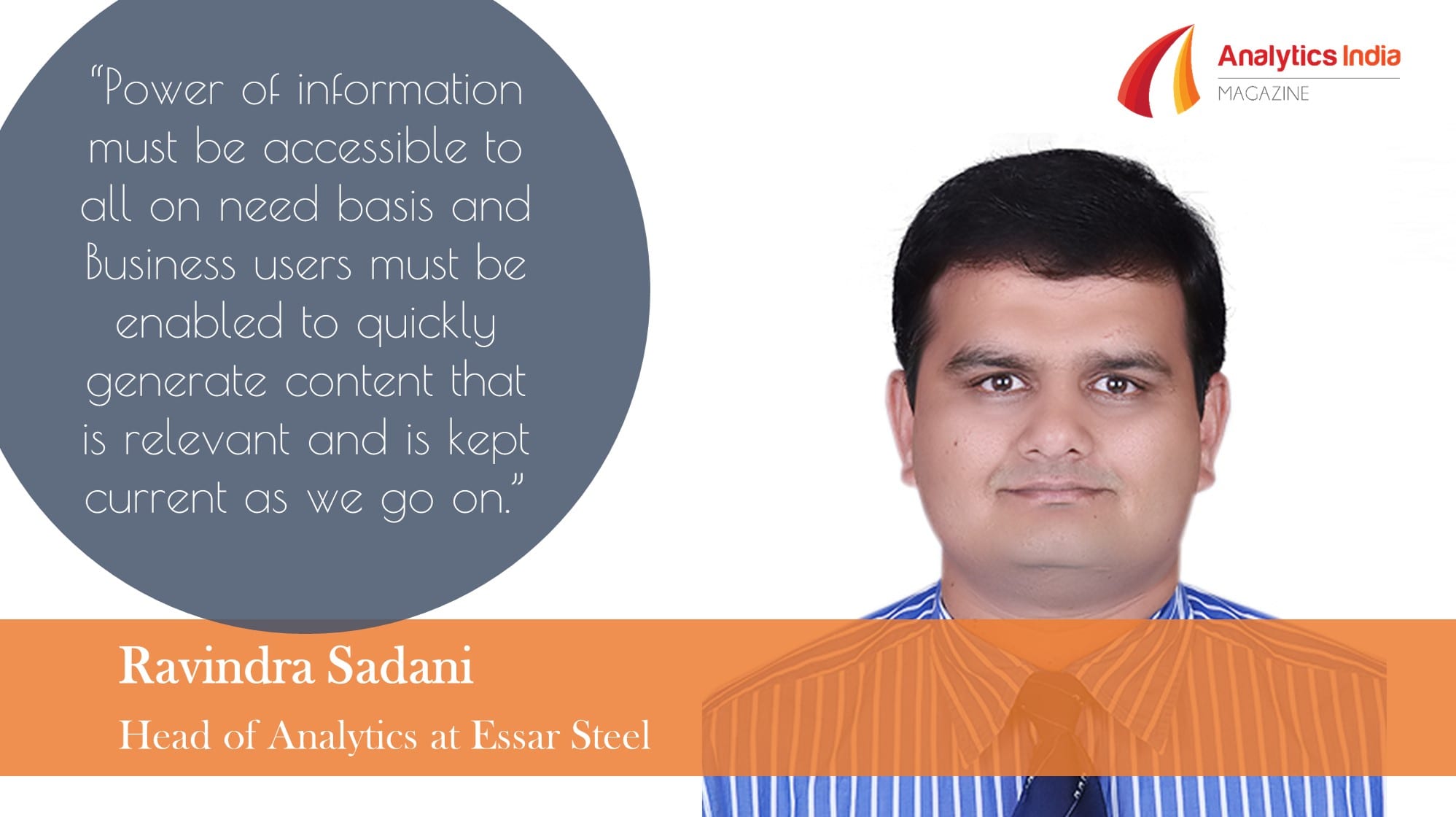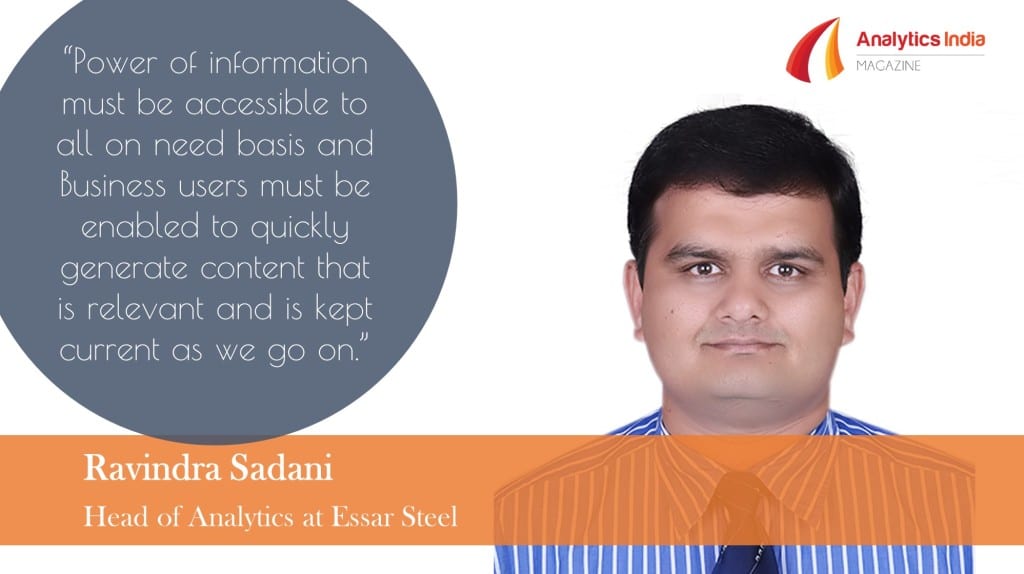Ravindra Sadani is the General Manager Business Planning and Analytics at Essar Steel. He has close to 2 decades of experience in Supply Chain Management function. He has worked in the industry as well as technology companies working as a Supply Chain consultant. Off late, he has been smitten by the Analytics bug and been instrumental in institutionalizing analytics culture at Essar Steel. His motto is business enablement through technology.
Ravindra speaks with Analytics India Magazine in this exclusive interview.
[dropcap size=”2″]AIM[/dropcap]Analytics India Magazine: Ravindra, thanks for this interview. Can you brief our readers about the focus areas of Analytics within Essar?
[dropcap size=”2″]RS[/dropcap]Ravindra Sadani: Thank you. In initial phase, we have focused on revenue analytics. Our aim was to mine the huge data that a transaction system like SAP generates and churn out actionable insights that help in decision making. Pricing analytics, Inventory management, Salesforce performance monitoring are some of the key solutions that we have delivered and found value in. We harnessed the power of a visual analytics tool like Tableau in this pursuit.
The two main tenets behind our analytics approach is democratization of information and self-service analytics. Power of information must be accessible to all on need basis and Business users must be enabled to quickly generate content that is relevant and is kept current as we go on. User created dashboards on top of IT managed infrastructure is the key.
AIM: Why is analytics needed in Essar Steel? Can you detail a specific use case to us?
RS: The need for analytics has always been there since business started. However based on the technological capabilities at that time we had different approach. However, we seriously felt that we are missing something and started scouting for a contemporary analytics solution in the summer of 2014. We chose Tableau and have come quite a distance in the last one year. Tableau has totally transformed the way we gather, present and consume information. The adoption of Tableau in our organization has spread like wildfire, credit to executive sponsorship from the CXO team.
Business is driving the analytics program and IT is supporting the business in this endeavor. This is the single biggest differentiator. Also our IT team has come up with an indigenous data consolidation solution which helps business design the way they would like the data structured and collected from system and non-system sources.
We have used analytics to generate the performance score cards of each individual in sales team. Various metrics have been defined and tracked online. Each Customer Account Manager has a dashboard which acts as a mirror which can help measure, monitor and improve performance. What used to get hidden under averages and team performances have been brought out of the closet. This when linked with rewards scheme has yielded significant performance improvement.
AIM: Tell us about your Analytics team. What skill sets do you look at while recruiting?
RS: Our analytics team comprises of about 20 team members with varying but complementary skills. There is an Executive sponsor who sets the strategic roadmap for the project and aligns it with corporate initiatives. Then there is a project manager who works with executive sponsor for executing the roadmap. There are team members who are database experts, business subject matter experts, Tableau champions, Tableau administrator. There is a core analytics group that takes care of governance aspects as we try to establish standards and best practices without hindering the creativity.
We look at learnability as today’s technologies are constantly changing. Only those who can learn and keep pace will make progress.
AIM: What are the planned next steps/ road ahead for analytics at Essar?
RS: We have carved out a roadmap to take next big steps in predictive and statistical analytics. So far the content that we have built mostly answers the questions like what happened, when it happened, we would like to now venture into the future and predict what could happen. Demand forecasting, Planning are some cases in sight.
Another aspect we are working on as we move from the growth to maturity phase in analytics journey is to bring in governance aspect. That is key as we scale up further.
AIM: What according to you are some of the key challenges in adoption of Analytics?
RS: Change management. Lack of standardization of definitions and data is the biggest impediment we face. The first thing we have to spend effort on while taking up any new analytics project is to clean up the source of information and standardize definitions. We have learnt that it takes complete support from the executive leadership to make this happen. Our CEO simply refused to recognize any reports that would come to him and does not comply to standards.
AIM: How did you start your career in analytics?
RS: I have been a Supply Chain Planning person all through my career. Last few years, I got smitten by this analytics bug and veered towards this area. A strong background of business as well as technology (I have worked in technology companies as Supply chain consultant) helped me frame my mission: Business enablement through technology. Analytics was the right platform to embark on this mission.
AIM: How do you see Analytics evolving today in the industry as a whole? What are the most important contemporary trends that you see emerging in the Analytics space across the globe?
RS: I will use the cliché – data is the new natural resource. Those who manage to mine and monetize this resource efficiently will be the winners of the future. Technology while it is big enabler, business must be at the forefront of driving this effort.
Analytics as a separate business function is slowly but steadily catching on and we will soon see titles like Chief Analytics Officer or Chief Data Officer become common in the organizations of tomorrow.
AIM: Anything else you wish to add?
RS: I would like to thank Analytics India to provide me this opportunity to share what we have done and learn from others what we can do more.












































































